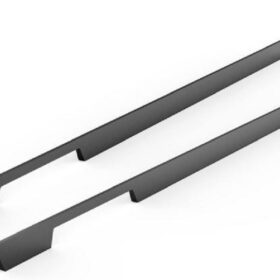The Environmental Impact of Cabinet Door Pull Handles
In the realm of interior design, the choice of cabinet door pull handles may seem like a trivial matter. However, these seemingly insignificant fixtures have a surprising impact on the environment, encompassing materials extraction, manufacturing processes, and disposal practices.
Material Impacts
Cabinet door pull handles come in a wide variety of materials, including:
Metals: Stainless steel, brass, and iron are durable and corrosion-resistant, but their extraction and processing consume significant amounts of energy.
Plastics: Cheap and easy to mold, plastics like PVC and ABS have a long lifespan but contribute to plastic waste accumulation.
Wood: Natural and sustainable, but deforestation and the use of harmful finishes can compromise its environmental friendliness.
Manufacturing Emissions
The manufacturing process for cabinet door pull handles involves various steps that release greenhouse gases.
Casting: Metal handles require casting, a process that generates emissions from melting and shaping the material.
Electroplating: Many metal handles undergo electroplating to enhance their finish, releasing chromium and other heavy metals into the environment.
Injection Molding: Plastic handles are produced through injection molding, which emits fumes and chemicals.
Disposal Challenges
When cabinet door pull handles reach the end of their lifespan, they pose disposal challenges.
Landfilling: Most handles end up in landfills, where they contribute to waste accumulation and can leach harmful substances into soil and groundwater.
Recycling: Some handles can be recycled, but the process is often inefficient due to mixed materials or finishes.
Composting: Wooden handles can be composted, but only if they are untreated and free of adhesives or finishes.
Sustainable Alternatives
To minimize the environmental impact of cabinet door pull handles, consider sustainable alternatives.
Recycled Materials: Handles made from recycled metals or plastics reduce the use of virgin materials and conserve resources.
Low-Emission Finishes: Powder coating and other low-emission finishes minimize the release of volatile organic compounds (VOCs).
Eco-Certified Woods: Handles made from wood certified by organizations like the Forest Stewardship Council (FSC) ensure responsible forestry practices.
Durable Designs: Handles built to last reduce the frequency of replacements and minimize waste.
Upcycling: Repurposing old handles or using them in new applications extends their lifespan and keeps them out of landfills.
The environmental impact of cabinet door pull handles may not be immediately apparent, but it encompasses a range of concerns from material sourcing to disposal practices. By choosing sustainable materials, supporting low-emission manufacturing, and opting for durable and recyclable handles, we can minimize our environmental footprint and contribute to a more sustainable future.
-
2024-11-29Top Trends in Modern Kitchen Cabinet Pulls for 2024
-
2024-11-28The Ultimate Guide to Modern Kitchen Cabinet Pulls- Materials, Styles, and Tips
-
2024-11-27Elevate Your Kitchen Design with These Must-Have Modern Cabinet Pulls
-
2024-11-26Sleek and Stylish- The Best Modern Kitchen Cabinet Pulls for a Contemporary Look










